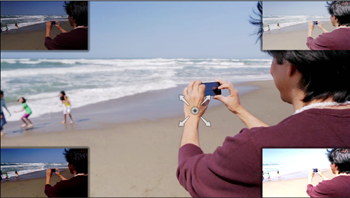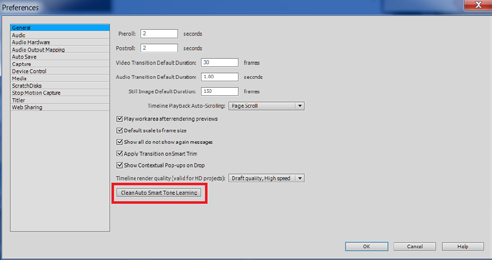Import your video clip to the timeline.
- Adobe Premiere Elements User Guide
- Introduction to Adobe Premiere Elements
- Workspace and workflow
- Working with projects
- Importing and adding media
- Arranging clips
- Editing clips
- Reduce noise
- Select object
- Candid Moments
- Color Match
- Smart Trim
- Change clip speed and duration
- Split clips
- Freeze and hold frames
- Adjusting Brightness, Contrast, and Color - Guided Edit
- Stabilize video footage with Shake Stabilizer
- Replace footage
- Working with source clips
- Trimming Unwanted Frames - Guided Edit
- Trim clips
- Editing frames with Auto Smart Tone
- Artistic effects
- Color Correction and Grading
- Applying transitions
- Special effects basics
- Effects reference
- Applying and removing effects
- Create a black and white video with a color pop - Guided Edit
- Time remapping - Guided edit
- Effects basics
- Working with effect presets
- Finding and organizing effects
- Editing frames with Auto Smart Tone
- Fill Frame - Guided edit
- Create a time-lapse - Guided edit
- Best practices to create a time-lapse video
- Applying special effects
- Use pan and zoom to create video-like effect
- Transparency and superimposing
- Reposition, scale, or rotate clips with the Motion effect
- Apply an Effects Mask to your video
- Adjust temperature and tint
- Create a Glass Pane effect - Guided Edit
- Create a picture-in-picture overlay
- Applying effects using Adjustment layers
- Adding Title to your movie
- Removing haze
- Creating a Picture in Picture - Guided Edit
- Create a Vignetting effect
- Add a Split Tone Effect
- Add FilmLooks effects
- Add an HSL Tuner effect
- Fill Frame - Guided edit
- Create a time-lapse - Guided edit
- Animated Sky - Guided edit
- Select object
- Animated Mattes - Guided Edit
- Double exposure- Guided Edit
- Special audio effects
- Movie titles
- Creating titles
- Adding shapes and images to titles
- Adding color and shadows to titles
- Apply Gradients
- Create Titles and MOGRTs
- Add responsive design
- Editing and formatting text
- Align and transform objects
- Motion Titles
- Appearance of text and shapes
- Exporting and importing titles
- Arranging objects in titles
- Designing titles for TV
- Applying styles to text and graphics
- Adding a video in the title
- Disc menus
- Sharing and exporting your movies
Auto Smart Tone is a powerful tool for automatically bringing your dull, dim, or washed-out videos to life. This feature uses a smart algorithm to modify the brightness and contrast of your video. The Auto Smart tone feature applies a correction to the scenes in your video. In addition to this, you have a controller that you can move around on the frame to fine-tune the results.


To apply the Auto Smart Tone to a video clip, follow these steps:
-
-
In the Adjust bar, select Adjust > Auto Smart Tone.
-
Select Apply to apply the auto smart tone to the video clip automatically. It analyzes the clip and divided it into visually similar scenes and a default correction is applied automatically. After auto correcting, if you want to adjust the brightness and contrast controls to make it look like you prefer, select Custom to initiate the Auto Smart Tone UI.
-
The clip gets divided into visually similar scenes (You can see the scene marks in the timeline).
-
Move the joystick control that appears on the frame, to fine-tune the resulting scene.
-
To see how the scene will appear when you move the controller in a specific direction, view the thumbnail images that appear at the four corners of the scene.
-
Click Done to apply the changes.
Auto Smart Tone learning
While using the Auto Smart Tone feature, you can select the Learn from this Correction check box. When you select the checkbox, the feature keeps learning from your editing actions on your videos. Each time you use the feature on a video, it places the correction (the controller) on the basis of what corrections you have applied to previous videos. The more videos you correct tonally through this feature, the more intelligent it becomes. The feature uses this learning to provide you with similar corrections on videos of the same type.
Resetting the learning
To reset the learning that the Auto Smart Tone feature has learned from your usage and actions, in the Preferences dialog, click General > Clean Auto Smart Tone Learning.

